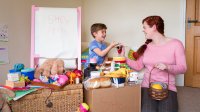Using Themes to Give Young Students a Sense of Purpose
Weekly themes like Chef Week make school fun while giving students a way to connect all the things they’re learning.
Your content has been saved!
Go to My Saved Content.Digital learning can get old. It can become harder and harder to vary without complicating our lives or our students’. This feels especially true for younger learners, who might struggle with navigating multiple apps or who need parental support for learning.
Fortunately, our younger learners have one great asset we can’t overlook—massive imaginations. The beauty of preschool and early elementary content is that it can easily be applied to any theme—and kids tend to be happy to play along when a topic interests them.
This spring, my kindergartener really struggled with distance learning. As a former teacher, I began to explore how we could dive into the curriculum in a more meaningful and engaging way.
Themes have been our solution. Themes enable students to create a narrative thread that binds the week’s content together, giving it a greater sense of purpose. One week we’re secret agents, the next ocean explorers. Covering content in this way has enabled us to breeze through standards in a fraction of the time and in a more hands-on way. Most important, it makes learning more exciting and turns each week into a new adventure.
Keep It Simple
Right now we’re in a time when less is more, so focus on keeping it basic. Suggest that students read anything that goes with the theme. Incorporate math concepts where they naturally fit. For example, measuring cups lend themselves to using basic fractions, which is perfect for a food week theme. For a secret agent theme, addition and subtraction answers can form a secret code.
Suggest extra activities that parents can lead at home to address standards, along with any extras you might not be able to get to in class. In fact, organizing learning into themes can help narrow down the search for supplemental activities and keep the prospect from getting overwhelming.
Right now, some parents of younger learners are sitting close by, so they might be happy to take on some easy activities and give their children a break from the screen. But make sure to communicate to parents that if that’s not their situation, it’s perfectly OK.
Here are a few ideas on what themed weeks might look like in kindergarten or first grade—and most of these will work in preschool as well.
Vet Week
Literacy: This week, the focus is on books about pets, animals on the farm, and animals at the zoo. Students do one drawing and one sentence a day in their journal related to the theme (e.g., “Pretend you’re a zoo vet. Draw a picture of the monkey’s cage. What did you put inside to make him/her happy?”)
Math: Students classify their stuffed animals into categories (e.g., pet, wild, farm). They pretend to be vets, first measuring the animals’ length and then weighing them. Vets give the stuffed animals a checkup, tallying who’s sick and who’s healthy.
Science: We talk about parts of the body (e.g., muscles, bones) and compare humans with different animals. We use an app called Pet Vet to take x-rays of animals.
Social studies: We make a map of the zoo, tracing the path the vet takes to visit the animals. Students make a map key.
SEL and art: We discuss how to care for and treat animals, emphasizing kindness. We draw some animal doodles with Mo Willems on YouTube.
Chef Week
Literacy: We focus on books about food and cooking. Students write one sentence plus one drawing per day in their journals using prompts. For example: What do you think is the best dessert in the world? What’s your family’s favorite thing to eat?
Math: We go over basic fractions using measuring cups and bake cookies. Later, we play store so that we can sell our cookies. We look in our cupboard for other snacks we can sell at our store and draw price tags for each so that we can practice using each type of coin.
Science: We create a food group scrapbook by cutting pictures from grocery ads and pasting them on sheets of paper. We do a blindfolded taste test to learn the five types of tastes. We also take out glasses of water and use food dye to test out what colors are created by mixing primary colors.
Social studies: We discuss foods from around the world and look at the map to see where certain dishes originated.
SEL and art: We discuss how food brings people together. We also attempt some food doodles using how-to videos from YouTube.
Using themes makes each week feel special and breaks up the monotony. Honestly, it’s even refreshing for the teacher. It helps make planning time more efficient—plus, it feels good to design weeks you know the kids are going to love. We all know there’s nothing like hearing a student say, “I can’t wait for next week!”
